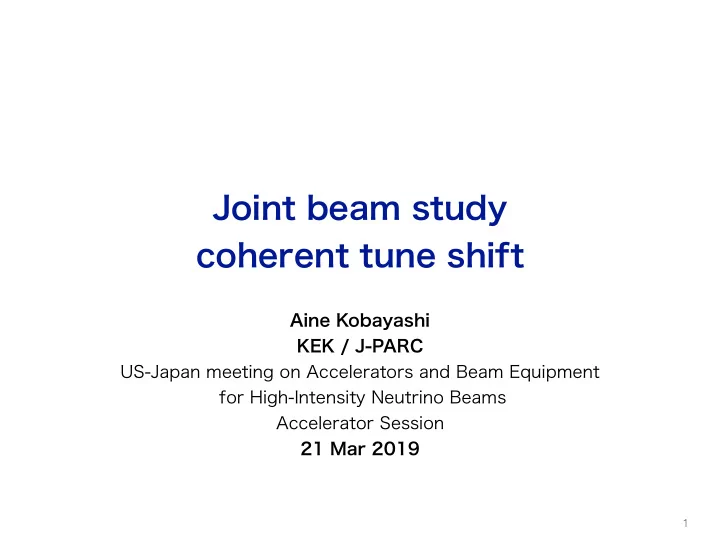

Joint beam study coherent tune shift Aine Kobayashi KEK / J-PARC US-Japan meeting on Accelerators and Beam Equipment for High-Intensity Neutrino Beams Accelerator Session 21 Mar 2019 � 1
Motivation : ν y ↓ beam poser 490 kW 2 4 6 8 bunches tune shift correction at J-PARC 2 4 6 8 bunches ν x beam loss 3ν x =64 2017 Dec. collaborated with MR monitor, beam comm. and magnet groups RCS MR 2 bunches × 4 times injections by 30 % after reduced correction acceleration injection acceleration injection MR for higher beam intensity bunch train tune shift correction is one of necessary element for higher beam power. before MR BLM �2 0 = y ν - x ν ν x + 2 ν y = 6 4 Power 451 kW Power 450 kW Loss 590 W Loss 850 W � 2
Motivation : current status dots : measured, dashed lines : fitted Estimations on the effects from beam impedance for tune shift are necessary. transverse-impedance sources : space charge and resistive wall of bunch-train tune shift. Lastlett (B.Ng) �3 • intensity, number of bunches and bunching factor dependences • difference of single bunch and multi bunches of tune shifts horizontal vertical • Simplified models based on main • It explains qualitatively the origin � 3
Motivation : current status RCS other parts : assumed circle cross-section circumference occupy 37 % for whole accelerator equidistance when injection bunch spacing is not MR (ongoing). for estimate wake field are tried measurements and considerations between models and measurements. �4 cross-section of bending magnet • There are some discrepancies • assumption (e.g. bunch spacing) • other impedance sources (kicker) • For quantity explanation, additional � 4
Joint beam study at FNAL RR (Thank you very much for arranging this opportunity, zKiyomi, Bob, FNAL peoples and US-Japan collaboration.) [Studied menu] horizontal direction �5 • 19 March 2019 • Rob Ainsworth, Aine Kobayashi and Kenichirou Satou • Recycler Ring • intensity, number of bunches and bunch length dependences : done last year for • intensity dependences • number of batches dependences • batch spacing dependences
Intensity dependence BPM:HP306 y [mm] amplitude amplitude turn turn tune tune x [mm] BPM:VP227 �6 horizontal horizontal vertical vertical horizontal vertical
Number of batches dependence at constant intensity consistent within the error (need to normalise intensity) intensity time time time time �7 horizontal vertical
Batch space dependence Consistent with two filling patterns. 81 bunches/1 batch 2 batches ̶ next to each other ̶ opposite sides �8 horizontal vertical
ξ→ 0 ξ x = -5.8, ξ y = -7.8 growth rate measurement Imaginary part of the tune shift Consistent with two filling patterns for both achromaticity settings. ̶ opposite sides ̶ next to each other 2 batches 8.1×10 12 ppp x [mm] 8.2×10 12 ppp ̶ opposite sides ̶ next to each other 2 batches turn turn y [mm] x [mm] turn turn y [mm] �9 horizontal horizontal vertical vertical
Summary necessary. study at FNAL RR. shifts were observed for both horizontal and vertical directions. distances. To do �10 • For higher beam intensity, understanding of tune shift mechanism is • For make a comparison between data and models, we had joint beam • Intensity dependences and number of batches dependences of tune • No apparent difference was observed in tune slope with different batch • Precise analysis of data and compare models. • Investigate on the impact of the wake length for other batches.
backups
Tune shift study in J-PARC MR [Collaborators] Aine Kobayashi, Takeshi Toyama, Yoichi Sato, Susumu Igarashi, Testushi Shimogawa, Fumihiko Tamura, Yasuyuki Sugiyama and Masahito Yoshii [Acknowledgements] Yong Ho Chin, Kazuhito Ohmi, Yasuhiro Shobuda, Kenichirou Satou, Hironori Kuboki, Jumpei Takano and all MR members JSPS KAKENHI Grant-in-Aid for Specially promoted Research, JP16H06288 Tune shift study in FNAL RR [Collaborators] Aine Kobayashi, Robert Ainsworth [Acknowledgements] Kiyomi Seiya, Kenichirou Satou and US-Japan collaboration US-Japan budget
Last year
Single bunch event measurements (2015/12/24) Multi bunch event measurements (2017/11/30) horizontal vertical by A. Kobayashi et al.
Recommend
More recommend